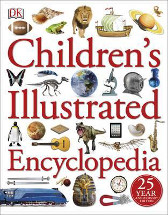Children's illustrated encyclopedia by Carolyn Bingham

Dorling Kindersley, 2016. ISBN 9780241238905
A few years ago, perhaps in an effort to be seen as a cutting-edge,
digital-age facility, many libraries weeded their reference
collections, disposing of almanacs, atlases and encyclopedias in the
belief that 'everything was now available on the Internet'. True,
some of those multi-volume sets did take up precious shelf space
even though they were seldom consulted but were retained because of
the expense of acquiring or replacing them. Those who sent them to
new homes (or the skip) were seen as brave and even now there are
libraries where one can find these sets taking pride of place
despite being years out of date.
But gradually there came a realisation that not everything was
available on the Internet and what was there was not necessarily
accessible physically or intellectually to those requiring it at
their point of need. In addition, research started to emerge about
the differences between reading print and digital material with
strong evidence that those who read, evaluate, interpret and use
online information best do so because they have a solid foundation
of traditional print-based skills. But it is tricky to help our
newest readers develop those skills if we no longer have that
traditional collection of print-based resources to offer them.
So this updated, 25th anniversary edition of the iconic Children's
illustrated encyclopedia is going to be a welcome addition to many
school and home libraries. It is hard to imagine that it is more
than a quarter of a century since Dorling Kindersley (DK)
revolutionised the presentation of non-fiction to cater for the
needs of younger readers with clear headings, smaller chunks of
information, clear, coloured illustrations and the use of white
space which decluttered the page and allowed the reader to feel more
in control rather than overwhelmed. With indices, glossaries,
quick-fact boxes and a host of other features DK pioneered this
new-look non-fiction which made all sorts of topics accessible to
the youngest readers who could learn much just from browsing the
pictures even if they couldn't read the words yet.
This 8th edition of the 1991 original covers nearly 400 topics,
arranged in the traditional alphabetical format, offering full or
double-page spreads on those things that young readers want to
investigate as well as new things that will catch their eye as they
navigate through it. One of the common arguments raised against the
cost of and access to online encyclopedias is that they have a
particular bias towards their country of publication, but this one
does not appear to favour anywhere over another. Australia has the
same amount of space as the United States; England has no more than
New Zealand.
Each topic is presented in that clear DK style and does what an
encyclopedia is supposed to do - offer an overview of each featured
topic that can be further explored in more in-depth texts if
desired. There is both a full index and gazetteer, critical for
developing effective search terms and location skills, as well as a
full list of acknowledgements so we can demonstrate the ethical use
of information and illustrations.
Even though it is heavy for little muscles, it would be a wonderful
and affordable way to introduce students to those essential,
traditional skills that are going to provide the platform for more
sophisticated use of non-fiction resources, print or online, in the
future. And being just one volume, it won't take up the real estate
of those older, more traditional sets. Parents and grandparents will
be pleased to know that there is something with which they are
familiar appearing on the shelves, and many will find their birthday
or Christmas gift problem solved.
Barbara Braxton